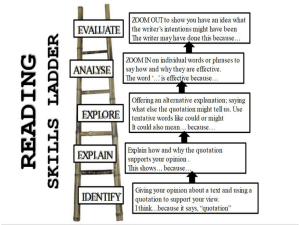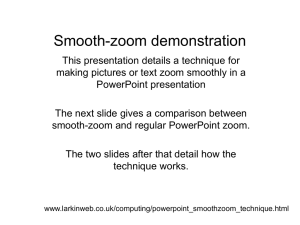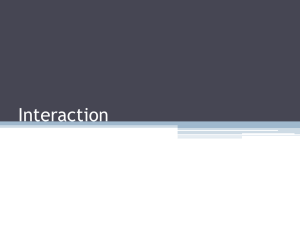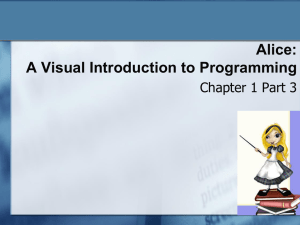zoom
advertisement
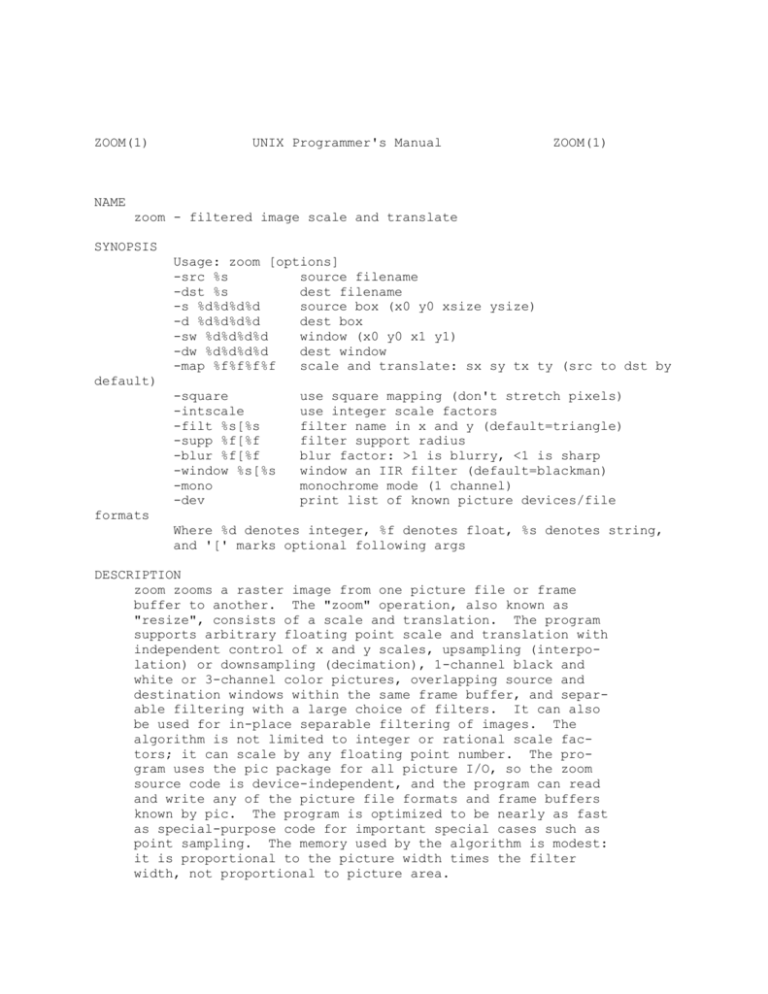
ZOOM(1) UNIX Programmer's Manual ZOOM(1) NAME zoom - filtered image scale and translate SYNOPSIS Usage: zoom [options] -src %s source filename -dst %s dest filename -s %d%d%d%d source box (x0 y0 xsize ysize) -d %d%d%d%d dest box -sw %d%d%d%d window (x0 y0 x1 y1) -dw %d%d%d%d dest window -map %f%f%f%f scale and translate: sx sy tx ty (src to dst by default) -square -intscale -filt %s[%s -supp %f[%f -blur %f[%f -window %s[%s -mono -dev use square mapping (don't stretch pixels) use integer scale factors filter name in x and y (default=triangle) filter support radius blur factor: >1 is blurry, <1 is sharp window an IIR filter (default=blackman) monochrome mode (1 channel) print list of known picture devices/file formats Where %d denotes integer, %f denotes float, %s denotes string, and '[' marks optional following args DESCRIPTION zoom zooms a raster image from one picture file or frame buffer to another. The "zoom" operation, also known as "resize", consists of a scale and translation. The program supports arbitrary floating point scale and translation with independent control of x and y scales, upsampling (interpolation) or downsampling (decimation), 1-channel black and white or 3-channel color pictures, overlapping source and destination windows within the same frame buffer, and separable filtering with a large choice of filters. It can also be used for in-place separable filtering of images. The algorithm is not limited to integer or rational scale factors; it can scale by any floating point number. The program uses the pic package for all picture I/O, so the zoom source code is device-independent, and the program can read and write any of the picture file formats and frame buffers known by pic. The program is optimized to be nearly as fast as special-purpose code for important special cases such as point sampling. The memory used by the algorithm is modest: it is proportional to the picture width times the filter width, not proportional to picture area. To run zoom, the user specifies the source and destination file or frame buffer names, specifies the mapping (zoom transformation) and filter. Most of these options have reasonable defaults. The program will read and write the full-screen area of the source and destination pictures by default; the user can specify subrectangles to read and write if desired. Rectangles can be defined in either of two ways: as a "box", which consists of xmin, ymin, xsize, ysize, or as a "window", which consists of xmin, ymin, xmax, ymax. By default, the source window is zoomed into the destination window. Alternatively, a mapping can be specified directly with the -map option. A mapping can be constrained to have equal scale in x and y, or to have integer scale factors, using the -square and -intscale options, respectively. Filters are selected with the -filt option. If given one filter name, -filt will use that filter in both x and y; if given two names, different filters can be used in the two dimensions. The command zoom -filt '?' prints the list of filters currently known to zoom. That list is: NAME SUPPORT point 0 box 0.5 triangle 1 quadratic 1.5 cubic 2 catrom 2 mitchell 2 gaussian 1.25 sinc 4 bessel 3.24 The option -filt point gives fast pixel replication, -filt triangle (the default) gives bilinear interpolation, which is suitable for most purposes, and -filt mitchell gives slower, very high quality results. The other filters are provided for experimentation. The time required by a filter is proportional to its support. Most of the filters known to zoom are FIR (finite impulse response), with an intrinsic support (width), but some of them (gaussian, sinc, bessel) are IIR (infinite impulse response), and must be truncated at some arbitrary support. This can be done with the -supp option. Again, the defaults are reasonable. The IIR filters can be windowed (brought down to zero) with various window functions listed below: hanning hamming blackman kaiser The sinc and bessel filters are blackman-windowed by default. Filters can be scaled artificially to blur or sharpen them with the -blur option. EXAMPLES zoom -src mandrill.dump Zoom the mandrill from picture file mandrill.dump into the default destination device (whatever that is), mapping the file's rectangle into the device's rectangle, with a triangle filter. zoom -src mandrill.dump -filt point -square -intscale Zoom the mandrill to the default device's full screen, but maintain the picture's aspect ratio, and zoom it up by an integer factor with point sampling (pixel replication) zoom -src mandrill.dump -dst iris -d 50 75 100 100 Zoom the mandrill into an iris window at position (50,70) with xsize=ysize=100. zoom -src hp -dst hp -s 100 100 640 512 -d 0 0 1280 1024 -filt mitchell Zoom from hp to itself with overlapping source and destination windows, using a mitchell filter. zoom -src hp -dst hp -s 0 0 500 500 -d 0 0 500 500 -filt cubic -blur 2 Blur (low pass filter) an image in-place. SEE ALSO pic(3), Discrete Time Signal Processing, Alan Oppenheim, Ronald Schafer, 1989. AUTHOR Paul Heckbert, August 1989. ph@cs.cmu.edu
